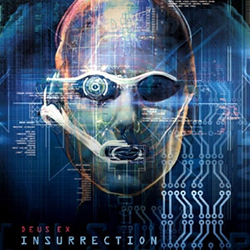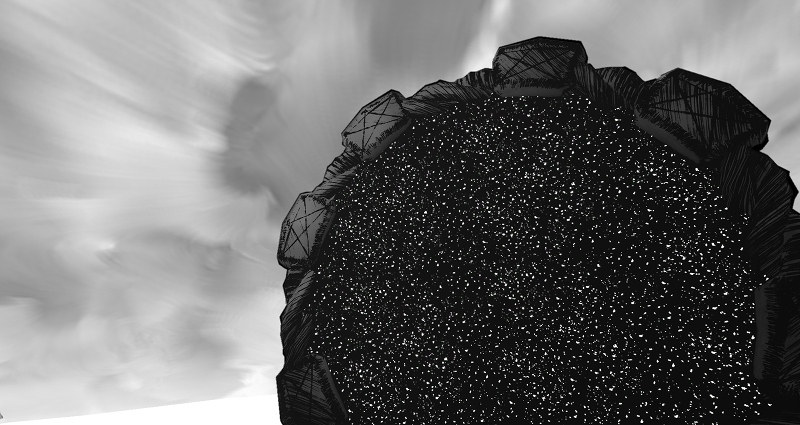Deus Ex Lost Sequels

Invisible War and Human Revolution - every Deus Ex fan knows about these sequels. But this is only part of the real story. Prior to Human Revolution, Ion Storm Austin’s studio, behind the creation of the first two parts of Deus Ex, worked on the third game in this series. Twice.
Now, an exclusive study and interview, offer a look at the creative process of Ion Storm and what could be an unfulfilled trilogy; never-announced games known as Deus Ex: Insurrection and Deus Ex 3.
We will start from the beginning.
Deus Ex: Insurrection - (2003 - 2004)
The story of Insurrection begins with the lead designer, Art Ming. Although he first joined Ion Storm as a programmer for Invisible War, the real reason behind his recruitment was always Deus Ex 3. After Invisible War, he was immediately promoted from programmer to project director and gave a team of 20 employees , the task of which was to create a new game in the Deus Ex series, entitled Insurrection.
"I left Valve specifically to lead the Insurrection development team," recalls Min. The team set about the project in the early stages of working on the concept and halfway from the start of production, before the situation went awry.
“We were still in preliminary development, using the Invisible War engine, when everything was over,” Min says. “We had prototypes, concepts, and an entirely planned plot.”
Even to start the preliminary development was not easy. Warren Spector's design documents uncovered at least four different storylines that were seriously proposed and moved beyond the initial ideas. Each of them had its own theme and place in the chronology of Deus Ex; each could lead a franchise to a new direction.

')
The first, entitled “Save Civilization”, proposed the role of a soldier in a detachment of secret government operations acting on behalf of an incorruptible president. After witnessing the destruction of Site 51 in the original game, you used cybernetic augmentations to uncover the Illuminati agents, restore democracy, and set the stage for the start of the Invisible War events. This scenario was supposed to be a rapidly developing journey around the world, starting with the siege of NSF in the White House and landing on the way in Moscow and London.
Other plots tended toward a more personal scale. One concept, known as the Foster Family, revolved around a long history of foster family members who could be responsible for the consequences of your decisions, and also had the ability to influence your career in the CIA.
“The more the player succeeded, the more he deserved the trust of US officials, many of whom are close friends of his or her spouse,” the notes explained. “Then the missions became more risky and less common ... (such as) the transfer of terrorist funds to the Swiss bank account or laser guidance on an American citizen to kill him from the air.
In the concept paper “The Adoptive Family,” family members constantly offered their thoughts regarding a great, but strangely uncertain, conspiracy in the game.
“I think we could accomplish this through a series of carefully focused missions,” says the final summary, in which Foster Family is positioned as the exact opposite of typical sandbox levels. "Each mission could maintain 2-3 strikingly different states depending on previously made decisions."
Meanwhile, other alleged plots originate from the Insurrection elsewhere in the main chronology. "Infiltrate the cult" begins after the Invisible War, based on the ending with JC Denton, in which humanity is connected to each other by nanotechnological group thinking. In this story, Paul Denton organizes autonomous resistance and prolongs his life using the cryogenics of the Illuminati.
Doors are closing
In the end, Ming departed from the original plans, and led the project in a different direction. Instead, Insurrection became a prequel to the first game, trying on the role of father / clone of JC Denton. And again, you were a spy in the service of the US government.
“We wanted to go back to the origins of the original game,” says Min. "I wanted real places in the world to be interconnected, as in the original, unlike the world of the future, in which everything was not justified."
According to Ming's script documents, the first mission would begin with the discovery that Chinese troops secretly infiltrated the United States and ended with an "Roswell event" that revealed to you the mysterious technology of human improvement. It would be unclear where this technology came from, but as events unfolded, you explored its origin, acquiring new abilities and allies in the face of America, China or the European Union.
"In other games of the Deus Ex series, science fiction nanotechnology and its social consequences were explored," said a draft design document. Insurrection returns the natural science of nanotechnology to a recognizable setting of the near future, where events are more understandable, but no less epic. ”
 Project Snowblind was originally a game in the Deus Ex series called Clan Wars.
Project Snowblind was originally a game in the Deus Ex series called Clan Wars.
Serving as the fourth part, due to the continued development of Deus Ex: Clan Wars (later released separately under the name Project Snowblind), Insurrection used the same engine as Invisible War, but alienated itself from its mistakes. Internal documents focused on larger levels and fewer dialogues, and StarCraft: Ghost was mentioned as a key influence in evidence.
However, eloquently more ambitious ambitions were specifically designed functions, some of which later appeared in games inspired by Deus Ex, such as Alpha Protocol (2010).
"The player ... has a home base where he can store equipment, rearm and heal between missions," explains the concept document. "[She] contained in herself: a briefing room, a meeting place, a clinic, an armory, a space in which history was developed based on moral principles, and a transition between missions."
Like the UNATCO headquarters in the original Deus Ex, and the Alpha Protocol shelter, the home base would provide a place to learn history through recruited allies. These allies would join the main Insurrection factions, and would react accordingly - making it difficult to recruit certain alliances or make decisions.
“[In Insurrection] the player builds an elite team that eventually develops its individuality. Do you hire a virtuoso hacker or weapon specialist? Would you be able to trust the marines rushing into battle, who were recruited in New York, if you now receive orders from the European Union? None of your team trusts the Chinese nanotechnology specialist - will you fire him or prefer to leave him to be in the know? ”
“We had 12-18 months of training and a team of 10-12 people when we stopped developing,” says Min, now executive producer of Rumble Studios. “We had prototypes of AI behavior and concept art ... I don’t remember, but it seems we also decided to return to conventional ammunition, not universal ones.”
“The game came to an end, because Warren Spector left Ion Storm. I left shortly after Warren, and a year later we founded the Junction Point studio. ”
Deus Ex 3 - (2004 - 2005)
When the Insurrection came to an end, it was not the last breath for the studio Ion Storm. Instead, Jordan Thomas took over the reins. Under his leadership, the remnants of the Ion Storm team were sent to a different vision of the project - the never-announced Deus Ex 3.
In any case, the Thomas team began work on Deus Ex 3 while Insurrection was still in development, in parallel creating a concept document that became legitimate, having managed to survive the rivalry.
According to Thomas, competing teams were not uncommon in Ion Storm, thereby implying that the studio culture was polarized and often obstructive. Ming, having joined as a programmer for the first time, and therefore having an idea of the team, describes Ion Storm as a down-to-earth studio - but Thomas says that the studio was dominated by charismatic personalities rather than practical processes.
"Basically, it was a cult of authors built around individuals",Says Thomas, stating that culture was founded on intellectual Darwinism.
“There was a feeling that we are doing important work. We were convinced that Ion Storm hired the best living developers, even though in reality it meant “mostly white men game designers who were passed through the school of thought Looking Glass”.

As a result, the project teams became so fragmented from each other that putting the documents on the Insurrection on the table, Thomas flipped through them, admitting that he was seeing them for the first time.
“Such materials reached us in a ridiculous way, intersections occurred between projects, but for whom they were assigned, it never became clear, especially when Warren left. It was a point of no return, because it was no longer there, and then a wave of major layoffs occurred, but the culture itself survived ... ”
It becomes sad, he falls silent before resuming with careful pride.
"Well, the cult of Deus Ex was important for the vision of everyone in the company, which is why I came there."
Thomas is not trying to hide his love for Deus Ex. He often hints at how she has changed his life and that his whole career began from a desire to work with a responsible team. This was probably what made him the natural leader of the project - well, and this was due to his recent success in developing the level of the infamous Shailbridge Cradle for Thief: Deadly Shadows.
Despite Thomas’s obvious passion, his vision of the project was radically different from everything the studio had tried to do earlier. Frankly speaking, Thomas set before the team the task of creating the truly first Deus Ex in the open world, which sacrificed global intrigues for the sake of a separate cyberpunk city - New Orleans.
Three companies
The first key to understanding the idea of Thomas was a completely new way of storytelling, using a generation system that created unique missions based on your actions in the game. He compares this system with the approach that was ultimately used in Far Cry 2, stating that the goal was to create a story that was directed rather than dictated.
The plot of Thomas was still the prehistory of the original Deus Ex and continued with the idea to try on the role of the father of JC. The difference was that in Deus Ex 3 you were an unsuccessful experiment by a biotechnology firm. Thrown away by their creators, and starting, literally, from the landfill, you had no choice but to become a mercenary.
And it was here that the generated stories would appear, secured by random missions that would enable one to rise from an experimental marriage to an elected super-soldier in the service of corporations. Over time, after a sufficient number of missions, you could stand in the same room with the leadership that created you - and kill him if you wish.
“Deus Ex was too abusive of the immortal NPCs, so we decided that you could kill anyone in the same room as you ... But we also had a trick that kept them alive,”Says Thomas. He explains this by saying that with the help of Dixie Flatline, you could gain access to the memories of your enemies, forcing them to become your advisors in your head.
Dixie Flatline - a reference to William Gibson's "Neuromants" - it was important for two reasons. First, he will keep the world semi-populated, even if you kill everyone you meet. Secondly, he would have allowed to preserve the nuances of the narration of other characters, besides the player himself. This would be vital because Thomas wanted to make Deus Ex 3 more than just a fantasy of revenge.
"I then and still pathologically avoid telling the players who they are," he says. "I wanted the social hierarchies around each company to become the key mechanics."
Social gameplay and generated storytelling only hint at how Deus Ex 3 could be different from other games in the open world. For example, there would be no vehicles or fast moving, on the pretext that all cars are tied to the DNA of their owners. By itself, the transport would be present, but since you do not have an identity card, this means that the cars are only suitable for throwing them at enemies in a difficult battle.
Instead, driving around New Orleans would require stealth or speed, as you hide your coarse, apparently robotic improvements. Jorjan describes stealth as being similar to Vampire The Masquerade: Bloodlines, in which the characters of the Nosferatu clan must move through the shadows and the sewers to hide their monstrous appearance. Speed tactics resembled Crackdown; many jumps between roofs, thanks to your augmentations.
Deus Ex 3: Fall
Although Deus Ex 3 was quite seriously written on paper, very little of this was recorded in the digital version due to the binding contract with Eidos, which implied the use of the Crystal Dynamics engine in all future projects. Earlier, Ion Storm used this engine when developing Deus Ex: Invisible War, the limitations of which were visible and noted by reviewers.
"It was a centralized promotion of the game," says Thomas. "At that time, it was wise to have one technically talented group in the publishing house, and everyone must use its technology to avoid developmental difficulties."
“As a result, this wisdom showed its inconsistency, but we had to show our achievements working on this technology. We built an inconclusive technical prototype of a physics engine that included car throwing, but the most polished element was the generated history system that James Clarendon worked on. ”
Ultimately, all the work was wasted. Eidos closed Ion Storm in 2005, after the departure of most key employees and continued financial failures. The official statement states that it is “consolidating technical and managerial capabilities into a smaller number of studios that can scale to meet competitive objectives.”
 At the moment, Thomas is working on the game The Magic Circle - and it’s hard not to find traces of Ion Storm in how it takes on the challenge of developing a game.
At the moment, Thomas is working on the game The Magic Circle - and it’s hard not to find traces of Ion Storm in how it takes on the challenge of developing a game.
During the one-hour conversation with Thomas, he seemed annoyed that he had once been enslaved by the charismatic culture of the studio Ion Storm, and explains the situation much easier.
“We failed. We were supposed to be the best of the best, but the best of the best failed with Thief: Deadly Shadows and Deus Ex: Invisible War. And so over and over again. ”
“There is a reason why this place is closed, and this reason is arrogance. Many people will tell you that the publisher has raped us, but no. Not. The method failed. No one bothered to create a small, more familiar Deus Ex. Even me.
Thomas believes that his aesthetics and methodology have changed over the years since Deus Ex 3. His current project The Magic Circle is a fictional remake of the game, abandoned by the creator, and his first independent game after leaving Ion Storm. A game in which you have to put together plot revisions against the background of the world with a deliberately broken code. It’s hard not to see a reproach to the failed authors in The Magic Circle - including the young Thomas.
“For many years I was sad about my failure with Deus Ex 3. I was convinced that I would be the only one who would finally kill the dragon that Chris Crawford had been pursuing over the years. I don’t believe it anymore. And do not miss.
Source: https://habr.com/ru/post/403495/
All Articles